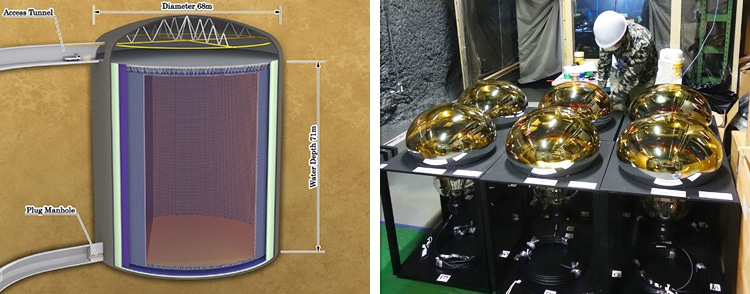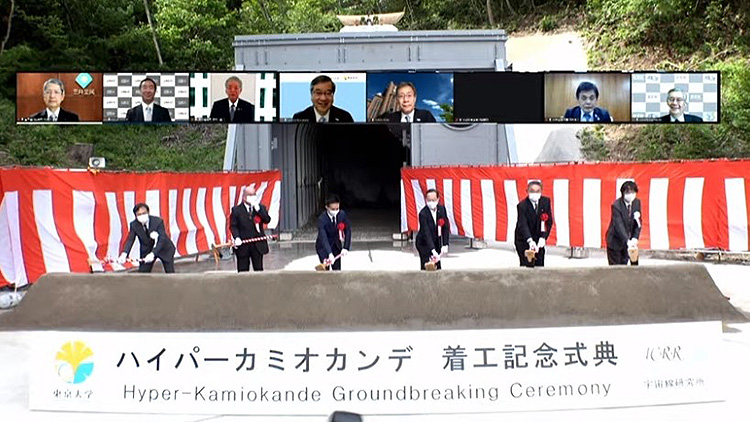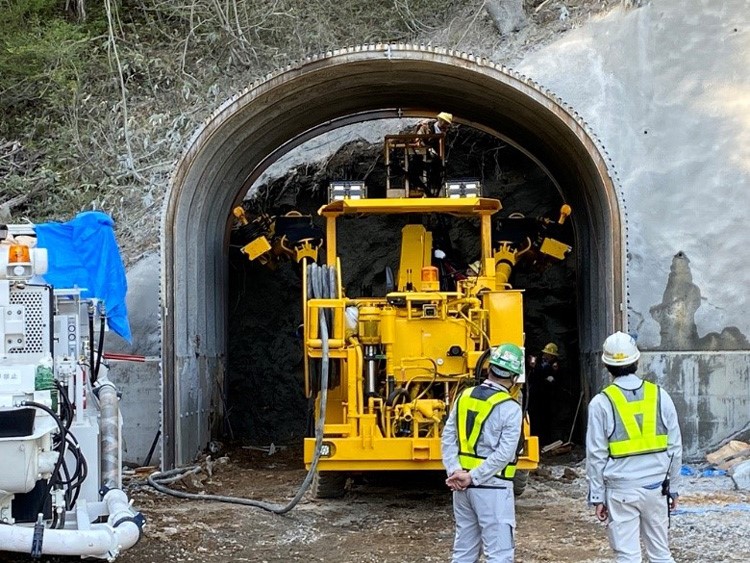Thanks to recent Nobel Prizes awarded in the physics field, the subatomic particle called a "neutrino" is now familiar to people around the world. Neutrinos are abundant in the universe, but they slip through our bodies unseen and untouched. These mysterious particles, also known as "ghost particles," are believed to hold the key to exploring the origins of substances and the universe and researchers are continuing their day-to-day observations and theoretical studies.
On May 28, the University of Tokyo held a ceremony commemorating the construction of Hyper-Kamiokande, a next-generation observation facility in Kamioka-cho, Hida City, Gifu Prefecture. It is expected to begin observations in 2027 as the successor to the current Super-Kamiokande with dramatically improved performance.
"Leading the world and achieving results"
The basic concept of Hyper-Kamiokande is to achieve significant results through the observation of neutrinos, which are extremely small and light compared to other subatomic particles and whose properties are hard to understand. A cylindrical tank with a diameter of 68 meters and a height of 71 meters will be constructed 650 meters underground. Forty thousand sensors called "photomultiplier tubes" will be installed on the inner walls, and 260,000 tons of water (190,000 tons of which are for observations) will be injected. Electrically neutral neutrinos can slip through objects, so the sensors are designed to detect the slight light produced by collisions with water molecules. Building the tank underground is to prevent other cosmic rays from interfering with the observation.
The effective volume of the tank will be ten times larger than that of Super-Kamiokande, and it will be possible to obtain 100 years' worth of data in about ten years. The sensitivity of the photomultiplier tubes will double, and their number (currently 11,000) will substantially increase.

© Hyper-Kamiokande Collaboration
This project, led by the University of Tokyo and High Energy Accelerator Research Organization (KEK), involves about 450 researchers from 19 countries. Japan will bear about 50 billion yen of the construction cost. The tunnel excavation started on May 6, and the construction work began on a full scale. At a ceremony held at the site and online on May 28, Masanori Yamauchi, Director General of KEK, stressed, "This is a vital and meaningful project in physics. I hope it will compete with similar projects around the world and produce results ahead of the rest."

(From the live coverage screen)
It's a microscope as well as a telescope
Masatoshi Koshiba, Special University Professor Emeritus at the University of Tokyo (passed away last November), won the Nobel Prize in 2002 for observing neutrinos produced by a "supernova explosion" that occurs at the end of a star's life at the first Kamiokande facility. Then Takaaki Kajita, Director of Institute for Cosmic Ray Research at the University of Tokyo, also won the Nobel Prize in 2015 for finding out that neutrinos have mass through observations at the Super-Kamiokande facility. The Hyper-Kamiokande, which will spec-up while retaining the basic functional mechanism of previous versions, has the characteristics of a microscope to observe subatomic particles and a telescope to observe astronomical and cosmic phenomena, will focus on three main themes:
(1) To precisely measure the neutrinos emitted from J-PARC, an experimental facility located 295 kilometers away in Tokai-mura, Ibaraki Prefecture, as well as neutrinos in the natural world. Following the discovery of some elementary particles, the group aims to discover the phenomenon of "CP Violation" in which "antiparticles" with opposite electrical properties disappeared while "particles" that constitute substances remained in the history of the universe. It may be possible to obtain a significant clue to discovering why the present-day universe is abound in matter.
(2) It is thought that only one type of force existed at the beginning of the universe, 13.8 billion years ago, which was eventually divided into four. Physics is working towards verifying the "Grand Unified Theory of Forces," which would explain all forces except gravity. The group aims to discover the proton decay predicted by this theory. "I have a high hopes that Hyper-Kamiokande will help us find proton decay. If it does, it will have a major impact on particle physics," said Yamauchi.
(3) To contribute to "neutrino astronomy," which observes neutrinos flying in from supernova explosions. The goal is to clarify the mechanism of the explosions. "The strength of Hyper-Kamiokande is that we can precisely observe the time, number, and energy of neutrinos coming from supernova explosions from moment to moment," said Masato Shiozawa, professor at Institute for Cosmic Ray Research, the University of Tokyo, and the experiment representative. The Hyper-Kamiokande will play a role in "multi-messenger astronomy" in conjunction with observations using visible light, X-rays, radio waves, cosmic rays, gravitational waves, and so on.
"It is truly wonderful that Japan is the host country"

In an online press conference, Kajita said, "Researchers worldwide believe that Hyper-Kamiokande is extremely important for science. It has taken more than 20 years since its conception, but it is truly wonderful that Japan can be the host country to realize it. I hope that the construction will proceed smoothly, and many good results will be produced."
The neutrino's mass is unknown, but it is said to be less than one-millionth of the electron, the lightest subatomic particle other than a neutrino. How will Hyper-Kamiokande tame this microscopic "ghost" and reveal the mysteries of the enormous universe?

©Hyper-Kamiokande Collaboration
Original article was provided by the Science Portal and has been translated by Science Japan.




